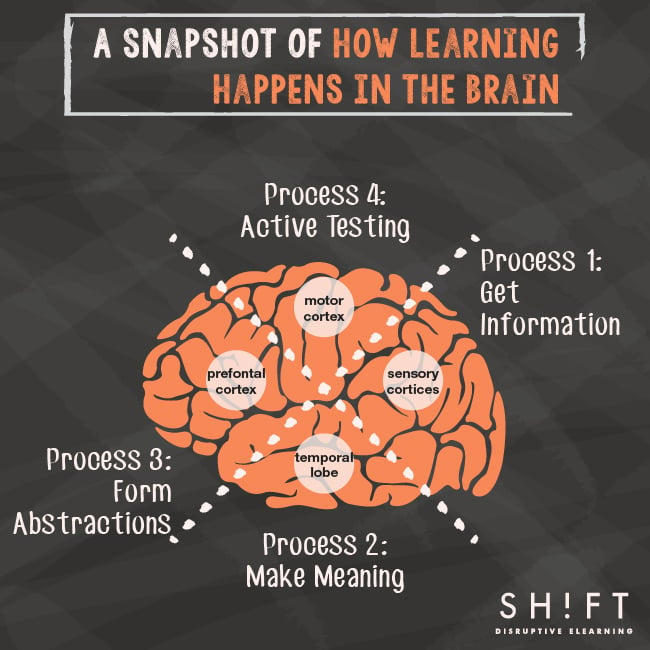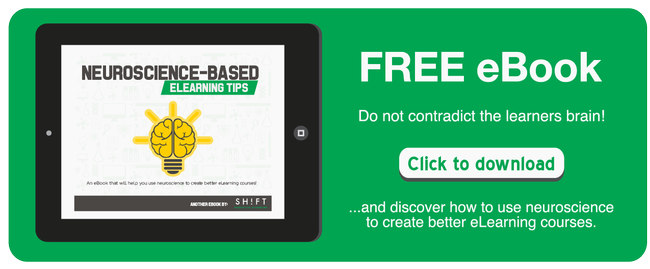In his book, The Art of Changing the Brain, Dr. James Zull , notably suggested how David Kolb's famous four-phase model of the learning cycle can be mapped into four major brain processes. He believed that better understanding the learning processes that occurs in the brain encourages a more flexible approach to learning. It does, by extension, help us become better eLearning developers and learners. After all, it's what's going on in the learners' brains that matters the most.
To grasp Zull's suggestion, you have to know first the four stages of Kolb's learning cycle. Here they are:
- Concrete Experience: This is when learners encounter a new learning experience
- Reflective Observation: Learners reflect on the experience
- Abstract Conceptualization: Think/Study (learn from the experience)
- Active Experimentation: Applying and trying out what was learned
Note that this is a recurrent four-stage process which, according to Dr. Zull, can be mapped into four differentiated brain processes. Here's an simple, biological, and clear overview of learning and the brain:

Process One: Get Information
The information-gathering part of the cycle engages the sensory cortices--the outer layer of our cerebral cortex that gets input from the outside of world of experience. It is through these cortices that we see, hear, touch, position, smell and taste. They basically record concrete experiences, or the raw materials for learning, in the brain.
Process Two: Make Meaning
All these new bits of data received from the sensory cortex flow toward the association regions in the back of the brain, where they start combining to produce a meaningful concept. Basically, making meaning out of raw information through reflection is the gist of this process. If we can find meaning in the subject being learned, the information can move into the working memory. It's the same mechanism responsible when a solution to a complex problem suddenly occurred. While it may seem somewhat mysterious, there is something concrete going on inside your brain while your creative juices start to flow.
First off, reflection needs time and space to happen. Without these, it is virtually impossible for learners to digest, search for connections (consciously or not), and integrate information already received.
This is why it's so important to carefully bake reflection into the eLearning materials you design. And you can significantly improve reflection by minding the amount of information and pace of delivering such information. It will give students enough time to reflect on the material and eventually make meaning out of it.
Process Three: Form Abstractions = Create
This executive brain process occurs when the prefrontal integrtative cortex is fully engaged. The learner moves past receiving and absorbing information and is now ready to create new knowledge, make relationships and form abstractions. Thus the learner starts making meaning in his or her own way, converting from being a receiver of knowledge to a creators of knowledge.
In Zull's words, this very process of creating abstractions should encourage us to “trust the brain to think,” to let learners learn through their natural processes. Basically, we should encourage the creation of knowledge rather than passive content consumption; this will result in longer lasting learning (Richland, Bjork, Finley & Linn, 2005).
Process Four: Active Testing
Active testing or trying out what you have learned involves the motor cortex. It's that part of the brain that coverts the abstract (mental ideas) into action (physical events). After the brain has interpreted experience through reflection and built meaning, at this point now, the brain uses these concepts created as guides for active testing or experimentation.
Active testing can manifest in several ways such as reading another book related to the subject, explaining or discussing a previous lesson with a peer, searching topics online related to the lesson, seeking out opinions from people who know more about the subject, and putting to practice what was learned back on the job.
Learning is an actual, recurrent process that occurs inside the brain. There's nothing mysterious about it. In fact, if you dig deep enough to understand the basics of how the brain learns, you'll be able to dramatically increase the effectiveness of your material. Grab whatever book you can on the subject. However, keeping in mind these four processes is a good start. If we as eLearning professionals hope for changing behavior and performance, a true completion of the cycle is needed.
Check out this visual representation, which summarizes this process clearly.
References:
The Neuroscience of Learning: A New Paradigm for Corporate Education. THE MARITZ INSTITUTE WHITE PAPER. May 2010




